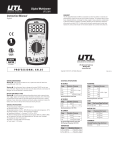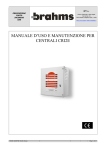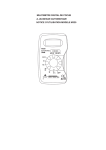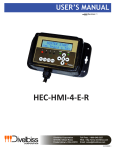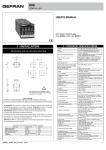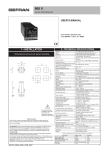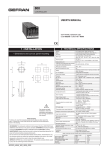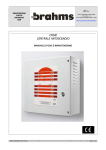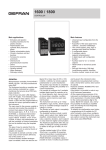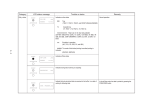Download addressing and test device minibt 05
Transcript
MINIBT 05 USER MANUAL CODE : MUMOI REV : 2 DATE: 27 / 06 / 08 PAGE : 1 ADDRESSING AND TEST DEVICE MINIBT 05 This document consists of 8 pages. MINIBT 05 USER MANUAL CODE : MUMOI REV : 2 DATE: 27 / 06 / 08 PAGE : 2 CONTENTS I. DOCUMENT’S EVOLUTION ...................................................................................2 II. GENERALITY .......................................................................................................3 III. CHARACTERISTICS.........................................................................................3 IV. OPERATING INSTRUCTION ..............................................................................4 Main menu ....................................................................................................................4 Manual address coding of an element..........................................................................4 Automatic address coding of an element.....................................................................5 Line verify .....................................................................................................................6 Warnings ......................................................................................................................7 V. RECOMMENDATIONS.........................................................................................7 Battery install/replace .................................................................................................7 Recommendations for addressing................................................................................8 I. DOCUMENT’S EVOLUTION REV MODIFICATIONS DATE 1 First release 03 / 07 / 06 MINIBT 05 USER MANUAL II. CODE : MUMOI REV : 2 DATE: 27 / 06 / 08 PAGE : 3 GENERALITY The “miniBT 05” is an electronic instrument designed to program and verify the DEFNET serial communication protocol addressable devices, such as fire/smoke detectors, manual call point, input/output modules and the lines composed by this devices. It is compatible with devices of series 95 and 05. “MiniBT 05” appears to the user as a rugged and practical plastic case; by means of its small outline, the case handle, and the possibility to install a battery to stand-alone from the main power supply, it results particularly user friendly for field application. III. CHARACTERISTICS By opening the case the user access the front panel, which present the following elements: • The main fused male+female plug (cable not provided), • The power on switch, • A sixteen characters over two lines LCD display, • A sixteen-keys keyboard, • A couple of spring-connector for fast line connecting, • A detector base. Electrical characteristics Parameter Main power supply Main protection Battery Battery protection Autonomy Main current Battery current Value 230Vac 50Hz Fuse 5x20mm 250V F400mA Pb 12V 1,9÷2,1Ah Polyswitch >6h < 50mAac standby < 250mAdc standby Mechanical characteristics Parameter Outline dimensions Weight Colour Protection grade Value 240 x 223 x 90mm 2,5Kg (with battery) Black IP55 (case closed) Inside the miniBT it takes place an electronic card that controls all the functionalities, and a battery recess. The battery is kept in charge by the main supply also when the miniBT is powered off. MINIBT 05 USER MANUAL IV. CODE : MUMOI REV : 2 DATE: 27 / 06 / 08 PAGE : 4 OPERATING INSTRUCTION The operations of the miniBT are driven by the user via the keyboard, which has the following keys: numeric keys 0÷9, direction key ↑ (up) to increment a value, ↓ (down) to decrement, ↵ (enter) to confirm, ← (backspace) to erase the selected numeric character, esc (escape) to go a step back, menu to go back to the main menu. The LCD displays operations and variables, note that the blinking block indicates to introduce a digit. Main menu At the power on, the following message appear for a while: Initialisation MiniBT-O Vx.y Then appear the main menu; the bottom line indicates the command achievable simply by pressing ↵. The options are scrollable (1-2-3-1… o 1-3-2-1…) using the arrows ↑ e ↓: MiniBT-O Vx.y 1 Manual coding 2 Autom. coding 3 Line verify The user can enter one of the commands also by pressing the associated number, for example press 3 to activate the line verify menu. Manual address coding of an element This function allows the user to modify the address of an element of which the actual one is known. After the command enter (either by pressing 1 form main menu or ↵ when this command is displayed), the LCD displays: Enter address to modify : ▒ The blinking block character indicates the position of the actual digit; this digit can stand for units (if no other digit will be introduced), tens (if only one other digit will be introduced) or hundreds (if other two digits will be introduced) of the variable under editing. In this case the variable indicates the actual address of the element (detector, MCP, module…) that will be modified. Note that if none digit is introduced, miniBT will assume the value zero. Press ← to erase last introduced digit (rectification) or ↵ to confirm the address and go to the next step; should the element with that address is not present, a “bip” is produced and the following message will appear for several seconds (after that the visualization goes back to the request of the address to modify): MINIBT 05 USER MANUAL CODE : MUMOI REV : 2 DATE: 27 / 06 / 08 PAGE : 5 Address xxx Not found If the element is present, its LED will blink and the display shows: New address tttttt: ▒ The bottom line contains the type of the element and the place to introduce the new address (cursor); after this value is entered press ↵ to confirm. If the new address is already present on the line, a “bip” is produced and the following message will appear for several seconds (after that the visualization goes back to the request of the new address): Address already present If the operation (change the address of an element) completed successfully, this message will appear until either menu or esc are pressed: Add. yyy tttttt address assigned Note that the LED of the element yyy will blink for the time the message is shown. Every time is requested to choose an address, if a value out of range is introduced a warning message is shown for several seconds: Address out of range (0-200) Automatic address coding of an element This is an effectiveness function useful to address sequentially a lot of elements, especially during a start-up. Thanks to the miniBT interactivity, the user can assign the address to all the elements directly on field without accessing the miniBT, which can be connected to any place of the detection line. The information exchange between user and miniBT uses the element’s LED and the opportunity to get the element in alarm. After the command enter (either by pressing 2 form main menu or ↵ when this command is displayed), the LCD displays: Address nbr. 0 searching At this moment, an element with the address 0 (default address for new elements) is searched either onto the base or the line; when found, miniBT suggests the first free address subsequent the last assigned address during the present session and, anyway, not already present; now the user can see on the display this suggested address or, if he is in the field, it has the information that a new address is ready to be assigned by means of the element’s LED blinking: MINIBT 05 USER MANUAL CODE : MUMOI REV : 2 DATE: 27 / 06 / 08 PAGE : 6 Add. 0 tttttt new address :xxx The new address can be confirmed either by pressing ↵ (if the user is close to miniBT), or by getting the element in alarm (via an apposite tool for the detectors, pressing MCP, module’s input activation…). This action inform the miniBT that the new address must be written into the element, a verify can be made by looking the LCD: Add. xxx tttttt address assigned The same time, the element’s LED will light up for 10 seconds. At the end of this period, the LED will turn off to indicate the miniBT is gone back to search address 0 for a new operation. Note that if the address of the element to search is not 0, it is possible, at this moment, to press ↵, the LCD shows: New address to search : ▒ Use numeric keys to enter desired value and confirm with ↵. If the address suggested by the miniBT is not desired, the user can press ↑ to skip it and display the next one. Line verify This function detects how many elements are connected to the miniBT over the line and the local detector base. Furthermore some informations about the elements are reported to the user. After the command enter (either by pressing 3 form main menu or ↵ when this command is displayed), the LCD displays: Total addresses found : qqq Where qqq indicates the amount of the elements connected to the miniBT. Note that it can take a lot of seconds to reach the real amount of elements. Press ↵ to display the information of the elements starting from lowest address: Element in standby state: Add. xxx tttttt state: normal Element in fault state: Element in alarm state: Dirty optical detector: Element no more answering: state: fault state: alarm state: dirty state: no answer During this visualization, the element’s LED blinks. Use ↑ and ↓ to walk through the elements. MINIBT 05 USER MANUAL CODE : MUMOI REV : 2 DATE: 27 / 06 / 08 PAGE : 7 Warnings Should the current to either the line or the local base exceed a given value, miniBT would cutoff line power for a lot of time and display the following message: WARNING ! Short circuit While stand-alone use, if the battery voltage fall down to an insufficient value, every 15 seconds a “bip” is generated and this message appears: WARNING ! Battery low V. RECOMMENDATIONS Battery install/replace Tools needed: a screwdriver and a 7mm hexagonal wrench. Turn off miniBT. Remove main cable. Close cover; turn the miniBT upside down and then remove the four screws. Open the cover and remove the metallic frame, the detector base can help in doing it. Remove the battery bracket by unscrewing the two M4 nuts. Disconnect battery and remove it (if a battery a present). Insert a new battery and connect it with the correct polarities: red cable +, black cable . ¾ Lock the battery with the bracket by screwing the two M4 nuts. ¾ Place the metallic frame into the plastic case. ¾ Turn the miniBT upside down and screw the four screws. ¾ ¾ ¾ ¾ ¾ ¾ ¾ WARNING: This device does not provide any battery circuit breaker when out of charge. When the battery is signalled low the user is strongly recommended to provide either its recharge or replace to avoid a deep discharge that can damage battery. MINIBT 05 USER MANUAL CODE : MUMOI REV : 2 DATE: 27 / 06 / 08 PAGE : 8 Recommendations for addressing For a correct use of miniBT and for the best element’s addressing during a fire detection system commissioning, please follow these indications: ¾ Collect all installation documents (plans, functional descriptions, particular requirements, …) and the manuals of the whole devices composing the system. ¾ Preview the elements placing to the panel’s lines taking in account installation requirements, panel’s limitations and power supply limitation. ¾ Set the address for any of the element of the installation. ¾ Either the addressing will be made manually or automatically, stick to any device (and related base, case, …) the appropriate label indicating the address. ¾ Factory default element’s address is 000. ¾ Do not place to a line two or more elements with the same address (also if 0) because of the conflicts that will be generated; this will give bad or impossible use of the line. ¾ Before placing addressable elements onto the line, make sure of the electrical characteristics of the line, especially conductors continuity (also the shield), no shortcircuit and no leakage between conductors.








